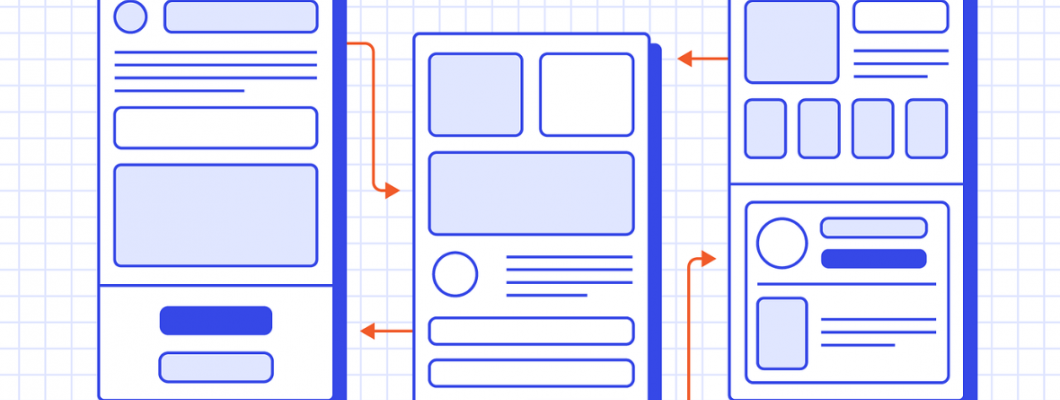
In the fast-paced world of digital product design, wireframing plays a critical role in shaping the user experience. Whether you’re designing a mobile app, website, or a complex software platform, wireframes serve as the blueprint, outlining structure, functionality, and navigation before any visual design or development begins.
Unlike polished mockups, wireframes are low-fidelity layouts that focus on user flow, content placement, and interface behavior. They help teams and stakeholders align on core features, define priorities, and identify usability issues early in the process. This makes wireframing not just a design step, but a strategic tool for collaboration, problem-solving, and iteration.
Effective UI/UX wireframes help reduce rework, improve communication, and create a clear roadmap for building intuitive, efficient digital experiences. From quick sketches on paper to detailed interactive prototypes, wireframes allow designers to test ideas, collect feedback, and make informed decisions at each stage.
In this blog, we’ll dive into the importance of wireframing, review the best tools for the job, and explore key strategies to craft better prototypes. Whether you're a designer, developer, or product owner, understanding wireframing fundamentals will elevate your design process and product success.
What Is a Wireframe?
A wireframe is a low-fidelity layout that outlines a product’s basic structure and functionality. It focuses on placement, hierarchy, and navigation rather than color, typography, or branding. Think of it as the skeleton of your digital interface—defining how users will interact with each part of the product.
Wireframes come in three levels:
Low-Fidelity: Simple black-and-white layouts, often with placeholder text and basic shapes.
Mid-Fidelity: More detailed with some real content and a closer layout to the final product.
High-Fidelity: Closely mimics the final design, often interactive and ready for usability testing.
Why Wireframing Is Essential for UI/UX Design
Wireframing is more than just a step in the design process—it's a collaboration tool, communication bridge, and problem-solving technique. Here's why it's critical:
1. Clarifies Design Intent
Wireframes help teams and stakeholders see the vision clearly, ensuring alignment before investing time in high-fidelity design or development.
2. Speeds Up Iteration
It's easier and faster to change a wireframe than a fully developed design. This flexibility promotes experimentation and improvement.
3. Improves User Flow
By focusing on functionality and user paths, wireframes highlight usability issues early in the process.
4. Saves Time & Cost
Catching layout or interaction problems early reduces costly rework during development.
Top Wireframing Tools (Free & Paid)
Choosing the right wireframing tool depends on your project’s complexity, team collaboration needs, and personal workflow. Here are some of the top tools:
1. Figma
Cloud-based, real-time collaboration
Great for both wireframing and high-fidelity design
Free plan available with powerful features
2. Adobe XD
Seamless integration with Adobe Creative Cloud
Allows interactive wireframes and prototypes
Ideal for teams already using Adobe products
3. Sketch
Popular among Mac users
Lightweight and intuitive
Excellent for wireframing and UI design
4. Balsamiq
Specifically focused on low-fidelity wireframes
Drag-and-drop simplicity
Great for quick ideation and client presentations
5. Axure RP
High-end tool for UX professionals
Includes logic, variables, and interactions
Useful for complex prototypes and enterprise-level apps
6. Moqups & Wireframe.cc
Browser-based wireframing tools
Minimal learning curve
Good for quick wireframes or brainstorming sessions
Strategies for Better Wireframing
Tools alone won’t guarantee success—how you use them matters. Here are expert strategies to elevate your wireframing game:
1. Start with User Goals
Every wireframe should begin with a clear understanding of the user's objective. What tasks do they want to accomplish? How can you minimize friction? Always prioritize the user’s perspective.
2. Sketch Before You Click
Don’t rush into a design tool. Use pen and paper to sketch rough ideas first. It frees your thinking and helps generate multiple layout options before committing to a digital version.
3. Keep It Simple
Use grayscale colors, basic fonts, and clear shapes. Avoid distractions like images, shadows, or branding at this stage. Focus on structure, not aesthetics.
4. Define a Clear Hierarchy
Use sizing, spacing, and layout to guide the user’s attention. Make primary actions obvious, group related elements, and design based on visual hierarchy principles.
5. Use Realistic Content Early
Instead of placeholder text, try to use real or realistic content as soon as possible. It helps anticipate layout issues and makes usability testing more authentic.
6. Annotate When Needed
Add notes to explain your design decisions or interactions, especially when handing off to developers or presenting to non-designers.
7. Test With Users
Even low-fidelity wireframes can be tested. Get feedback on user flow and layout before moving into high-fidelity design or development.
8. Use Components & Templates
Speed up your workflow by using UI kits, reusable components, or design systems. Tools like Figma and Adobe XD allow for component-based design, saving time and maintaining consistency.
Common Wireframing Mistakes to Avoid
Skipping user research: Don’t design in a vacuum.
Overcomplicating layouts: Cluttered wireframes confuse more than they help.
Designing for one device only: Always consider responsiveness.
Ignoring feedback: Wireframes should evolve based on stakeholder and user input.
Jumping to high fidelity too soon: Validate structure before adding polish.
From Wireframe to Prototype: What’s Next?
Once your wireframes are validated and refined, it’s time to transition into high-fidelity mockups and interactive prototypes. These will include detailed visuals, branding elements, and user interactions like hover states and page transitions.
Many wireframing tools (like Figma, Adobe XD, and Sketch) allow seamless transitions to prototypes without starting from scratch. You can also import your wireframes into tools like InVision or Framer to create clickable prototypes and gather feedback.
Conclusion
UI/UX wireframing is a foundational skill that shapes the user experience before any visual design or development begins. With the right tools and strategies, wireframes help you build better products faster, smarter, and with fewer surprises down the road.
Whether you're a solo designer or part of a cross-functional team, wireframing encourages collaboration, innovation, and user-centric thinking. So grab a pen or open your favorite design tool and start sketching the next great digital experience.

Leave a Comment